Structure and Operation Optimization of a Form-Stable Carbonate/Ceramic-Based Electric Thermal Storage Device for Space Heating
Abstract
1. Introduction
2. Materials and Methods
2.1. Preparation of the Form–Stable Phase–Change Bricks
2.2. Characterization of the Form–Stable Phase–Change Bricks
2.3. The Structure of the ETSD
2.4. Calculation Methods
2.4.1. Calculation of Heat Storage Ratio
2.4.2. Calculation of the Air Mass Flow
2.5. Simulation Method
3. Results and Discussion
3.1. Thermal Properties of the Form–Stable Phase–Change Bricks
3.2. Temperature Distributions of the FS–PCM Bricks in 2D and 3D
3.2.1. Experiments of Temperature Distribution in FS–PCM Bricks in Two Dimensions, with and without Steel Plates
3.2.2. Experiments of Temperature Distribution with Different Insulation Layers
3.2.3. Simulated Temperature Distribution of FS–PCM Bricks with Steel Plates in Three Dimensions
3.3. Energy Analysis
3.4. Cycle Testing of the Optimum Structured ETSD
3.5. Application and Economic Analysis
3.5.1. Applying the Optimized ETSD in a Room
3.5.2. Economic Analysis
4. Conclusions
Author Contributions
Funding
Data Availability Statement
Conflicts of Interest
Nomenclature
| Symbols | |||
| A | Area, [m2] | γ | Specific gravity of the atmosphere |
| c | Stefan–Boltzmann constant, [W/K4] | α | Thermal diffusion coefficient, [m2/s] |
| d | Thermal insulation diameter, [m] | λ | Thermal conductivity, [W/m·K] |
| f | Mass flow, [m/s] | Abbreviation | |
| g | Gravity, [m/s2] | Bi | Biot |
| H | Height change, [m] | ETSD | Electric thermal storage device |
| h | Heat transfer coefficient, [W/(m2·K)] | FS–PCM | Form stable PCM |
| l | Length, [m] | PCM | Phase-change material |
| m | Mass, [g] | TES | Thermal energy storage |
| n | Coefficient, [-] | Subscripts | |
| P | Power, [kW] | 0 | Ambient |
| p | Pressure, [Pa] | 1 | Part 1 |
| q | Heating power, [kW] | 2 | Part 2 |
| Q | Heating energy, [KJ] | c | Convective |
| R | Thermal resistance, [K/W] | cr | Critical |
| T | Temperature, [°C] | cov | Convective heat transfer |
| t | Time, [s] | e | Electricity |
| y | Height direction, [m] | i | Internal |
| Greek Symbols | il | Insulation | |
| η | Efficiency, [%] | r | Radiative |
| ε | Emittance, [-] | sp | Steel plate |
| τ | Time, [s] | st | Storage |
| ν | Atmospheric velocity, [m/s] | w | Wall |
References
- Niu, D.X.; Song, Z.Y.; Xiao, X.L. Electric power substitution for coal in China: Status quo and SWOT analysis. Renew. Sustain. Energy Rev. 2017, 70, 610–622. [Google Scholar] [CrossRef]
- Wei, X.; Zhou, H. Evaluating the environmental value schedule of pollutants mitigated in China thermal power industry. Res. Environ. Sci. 2003, 16, 53–56. [Google Scholar]
- Lin, L.; Cao, R.; Feng, L. Investigation of boilers energy alternative outside the region of Nanjing heating supply. Power Demand Side Manag. 2010, 12, 47–49. [Google Scholar]
- Xu, G.; Hu, X.; Liao, Z.; Xu, C.; Yang, C.; Deng, Z. Experimental and Numerical Study of an Electrical Thermal Storage Device for Space Heating. Energies 2018, 11, 2180. [Google Scholar] [CrossRef]
- Arteconi, A.; Hewitt, N.J.; Polonara, F. State of the art of thermal storage for demand-side management. Appl. Energy 2012, 93, 371–389. [Google Scholar] [CrossRef]
- Zhang, N.; Lu, X.; McElroy, M.B.; Nielsen, C.P.; Chen, X.; Deng, Y.; Kang, C. Reducing curtailment of wind electricity in China by employing electric boilers for heat and pumped hydro for energy storage. Appl. Energy 2016, 184, 987–994. [Google Scholar] [CrossRef]
- Tian, Z.Y.; Perers, B.; Furbo, S.; Fan, J.H. Thermo-economic optimization of a hybrid solar district heating plant with flat plate collectors and parabolic trough collectors in series. Energy Convers. Manag. 2018, 165, 92–101. [Google Scholar] [CrossRef]
- He, Z.Y.; Wang, X.H.; Du, X.Z.; Amjad, M.; Yang, L.J.; Xu, C. Experiments on comparative performance of water thermocline storage tank with and without encapsulated paraffin wax packed bed. Appl. Therm. Eng. 2019, 147, 188–197. [Google Scholar] [CrossRef]
- Lin, K.; Zhang, Y.; Xu, X.; Di, H.; Yang, R.; Qin, P. Experimental study of under-floor electric heating system with shape-stabilized PCM plates. Energy Build. 2005, 37, 215–220. [Google Scholar] [CrossRef]
- Li, J.; Xue, P.; He, H.; Ding, W.; Han, J. Preparation and application effects of a novel form-stable phase change material as the thermal storage layer of an electric floor heating system. Energy Build. 2009, 41, 871–880. [Google Scholar] [CrossRef]
- Yuan, M.D.; Ren, Y.X.; Xu, C.; Ye, F.; Du, X.Z. Characterization and stability study of a form-stable erythritol/expanded graphite composite phase change material for thermal energy storage. Renew. Energy 2019, 136, 211–222. [Google Scholar] [CrossRef]
- Ren, Y.X.; Xu, C.; Yuan, M.D.; Ye, F.; Ju, X.; Du, X.Z. Ca(NO3)(2)-NaNO3/expanded graphite composite as a novel shape-stable phase change material for mid- to high-temperature thermal energy storage. Energy Convers. Manag. 2018, 163, 50–58. [Google Scholar] [CrossRef]
- Musiał, M.; Lichołai, L.; Pękala, A. Analysis of the Thermal Performance of Isothermal Composite Heat Accumulators Containing Organic Phase-Change Material. Energies 2023, 16, 1409. [Google Scholar] [CrossRef]
- Zhou, W.; Li, S.; Feng, Y.; Lin, L. Evaluation and optimization on heat transfer performance of a composite phase change material embedded in porous ceramic skeleton: A lattice Boltzmann study. Int. J. Therm. Sci. 2023, 188, 108214. [Google Scholar] [CrossRef]
- Tariq, S.L.; Ali, H.M.; Akram, M.A.; Janjua, M.M.; Ahmadlouydarab, M. Nanoparticles enhanced phase change materials (NePCMs)-A recent review. Appl. Therm. Eng. 2020, 176, 115305. [Google Scholar] [CrossRef]
- Li, W.Q.; Guo, S.J.; Tan, L.; Liu, L.L.; Ao, W. Heat transfer enhancement of nano-encapsulated phase change material (NEPCM) using metal foam for thermal energy storage. Int. J. Heat Mass Transf. 2021, 166, 120737. [Google Scholar] [CrossRef]
- Halawa, E.; Saman, W. Thermal performance analysis of a phase change thermal storage unit for space heating. Renew. Energy 2011, 36, 259–264. [Google Scholar] [CrossRef]
- Kuznik, F.; Arzamendia Lopez, J.P.; Baillis, D.; Johannes, K. Design of a PCM to air heat exchanger using dimensionless analysis: Application to electricity peak shaving in buildings. Energy Build. 2015, 106, 65–73. [Google Scholar] [CrossRef]
- Jiang, Z.; Jiang, F.; Li, C.; Leng, G.; Zhao, X.; Li, Y.; Zhang, T.; Xu, G.; Jin, Y.; Yang, C.; et al. A Form Stable Composite Phase Change Material for Thermal Energy Storage Applications over 700 °C. Appl. Sci. 2019, 9, 814. [Google Scholar] [CrossRef]
- Gaffar, S.A.; Prasad, V.R.; Bég, O.A. Numerical study of flow and heat transfer of non-Newtonian Tangent Hyperbolic fluid from a sphere with Biot number effects. Alex. Eng. J. 2015, 54, 829–841. [Google Scholar] [CrossRef]
- Loveday, D.L.; Taki, A.H. Convective heat transfer coefficients at a plane surface on a full-scale building facade. Int. J. Heat Mass Transf. 1996, 39, 1729–1742. [Google Scholar] [CrossRef]
- Zhang, H.; Jiang, C.; Zhang, Z.; Liu, Z.; Luo, X.; Liu, W. A study on thermal performance of a pump-assisted loop heat pipe with ammonia as working fluid. Appl. Therm. Eng. 2020, 175, 115342. [Google Scholar] [CrossRef]
- Brigaud, F.; Vasseur, G. Mineralogy, porosity and fluid control on thermal conductivity of sedimentary rocks. Geophys. J. Int. 1989, 98, 525–542. [Google Scholar] [CrossRef]
- Lu, Y.; Zhang, G.; Hao, J.; Ren, Z.; Deng, Z.; Xu, G.; Yang, C.; Chang, L.; Tan, H. Study on the effect of glass on the properties of Na2CO3-K2CO3 eutectic salt/MgO composite as phase change thermal storage materials. Energy Sources Part A Recovery Util. Environ. Eff. 2020, 1–12. [Google Scholar] [CrossRef]
- Li, B.-R.; Tan, H.; Liu, Y.; Liu, Q.; Zhang, G.-Q.; Deng, Z.-F.; Xu, G.-Z.; Guo, Y.-Q.; Du, X.-Z. Experimental investigations on the thermal stability of Na2CO3–K2CO3 eutectic salt/ceramic composites for high temperature energy storage. Renew. Energy 2020, 146, 2556–2565. [Google Scholar] [CrossRef]
- Li, C.; Si, Y.; Leng, G.; Xu, Y.; Ding, Y.; Weng, L.; Ding, Y. Charging behavior of an electrical storage heater using a high temperature composite phase change material. Energy Storage Sci. Technol. 2017, 6, 739. [Google Scholar]


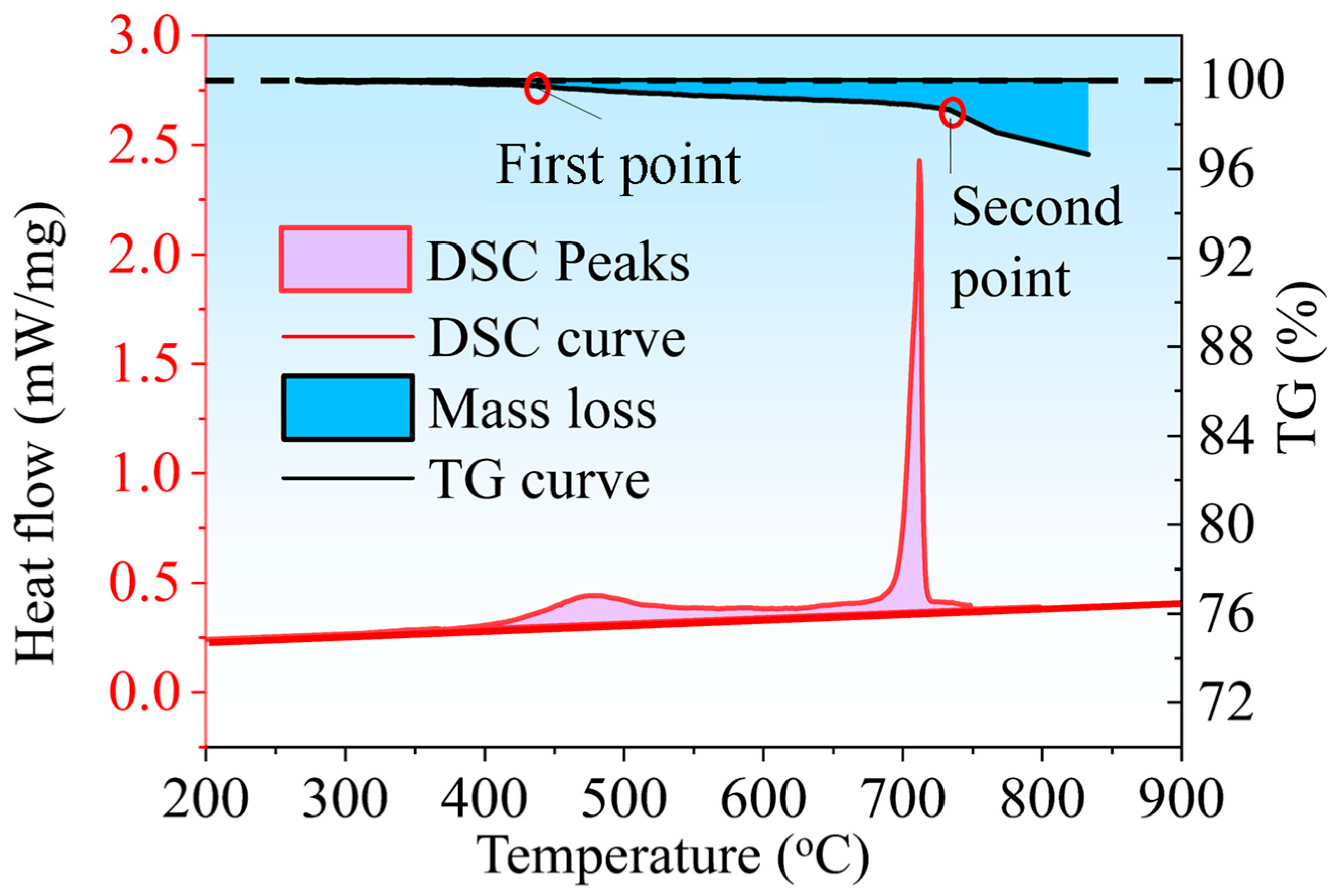
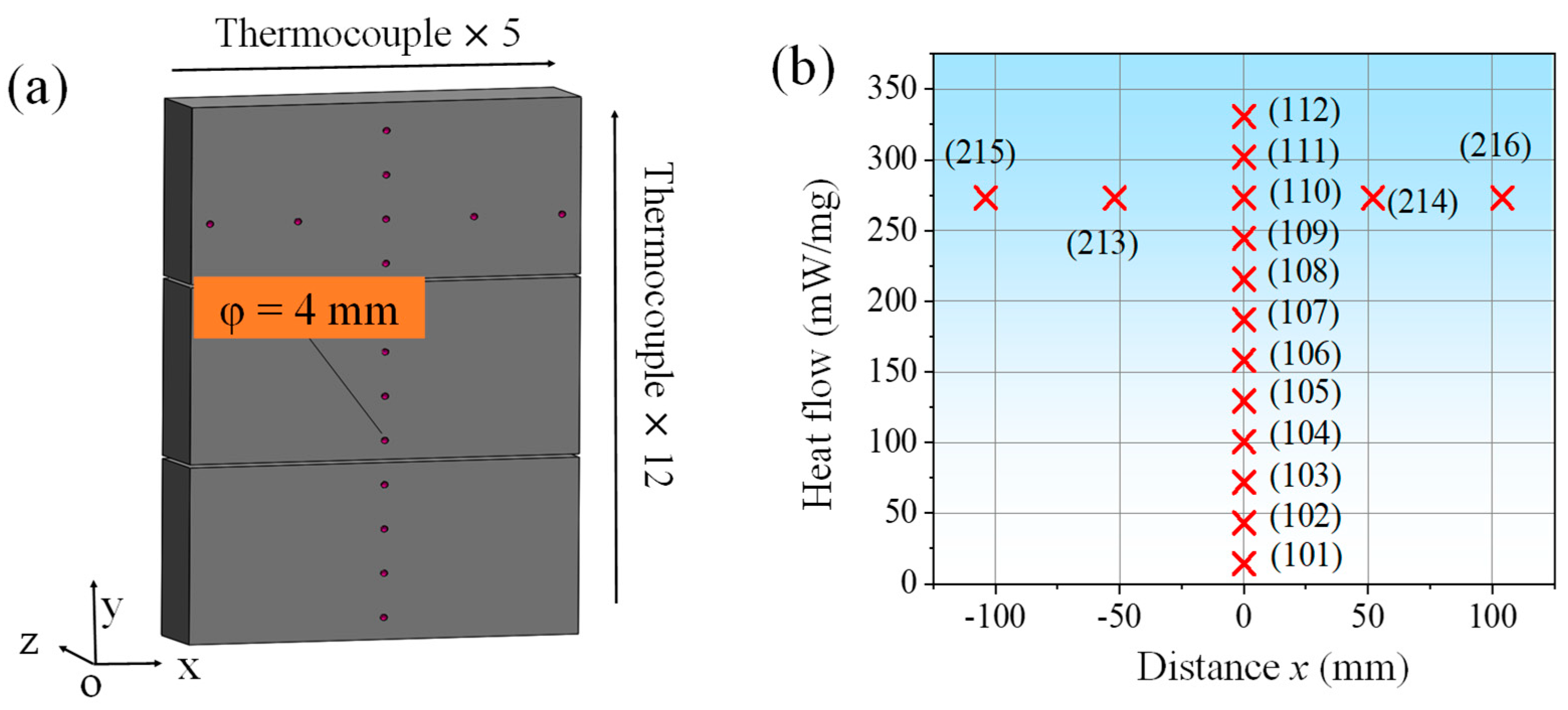

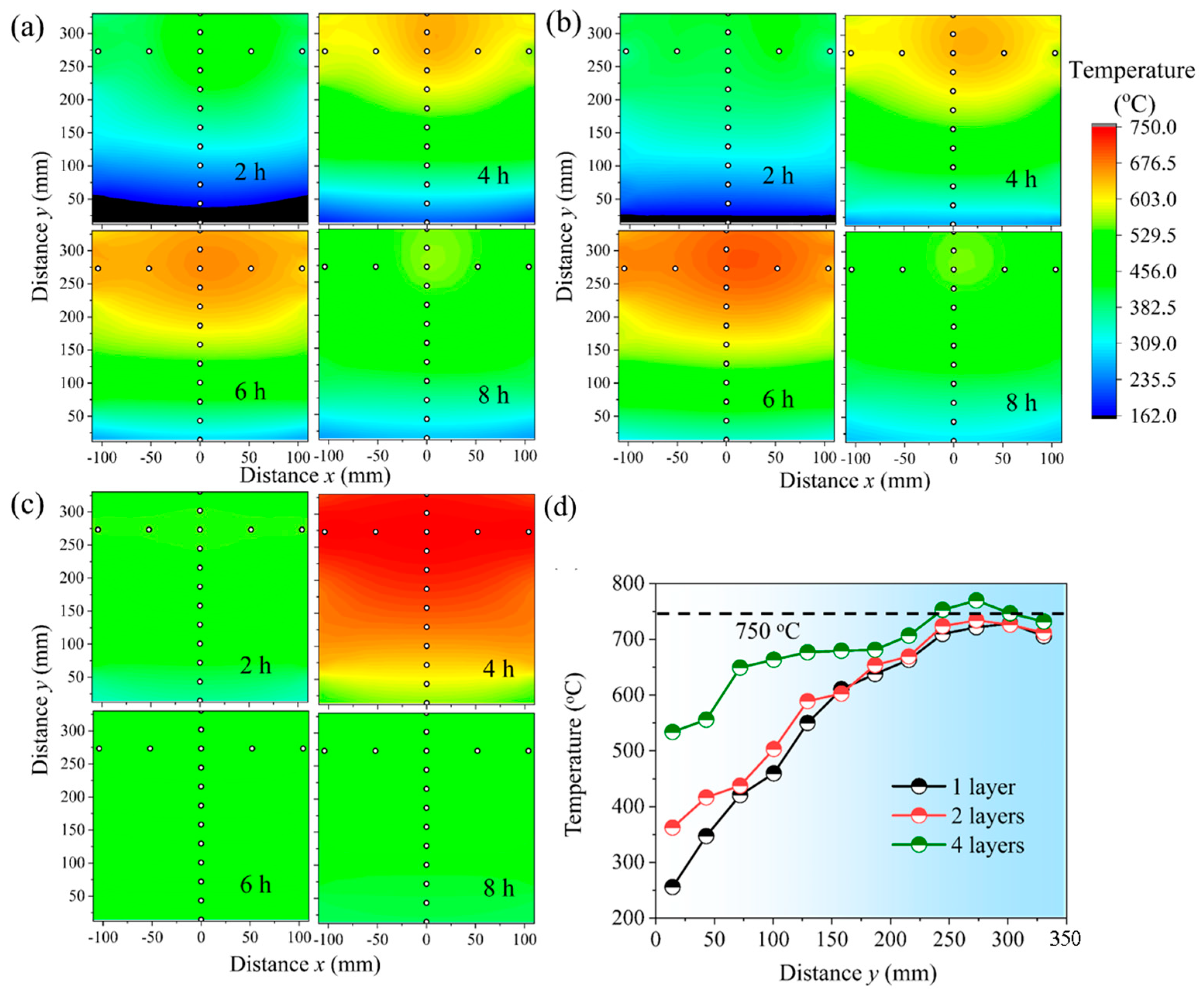
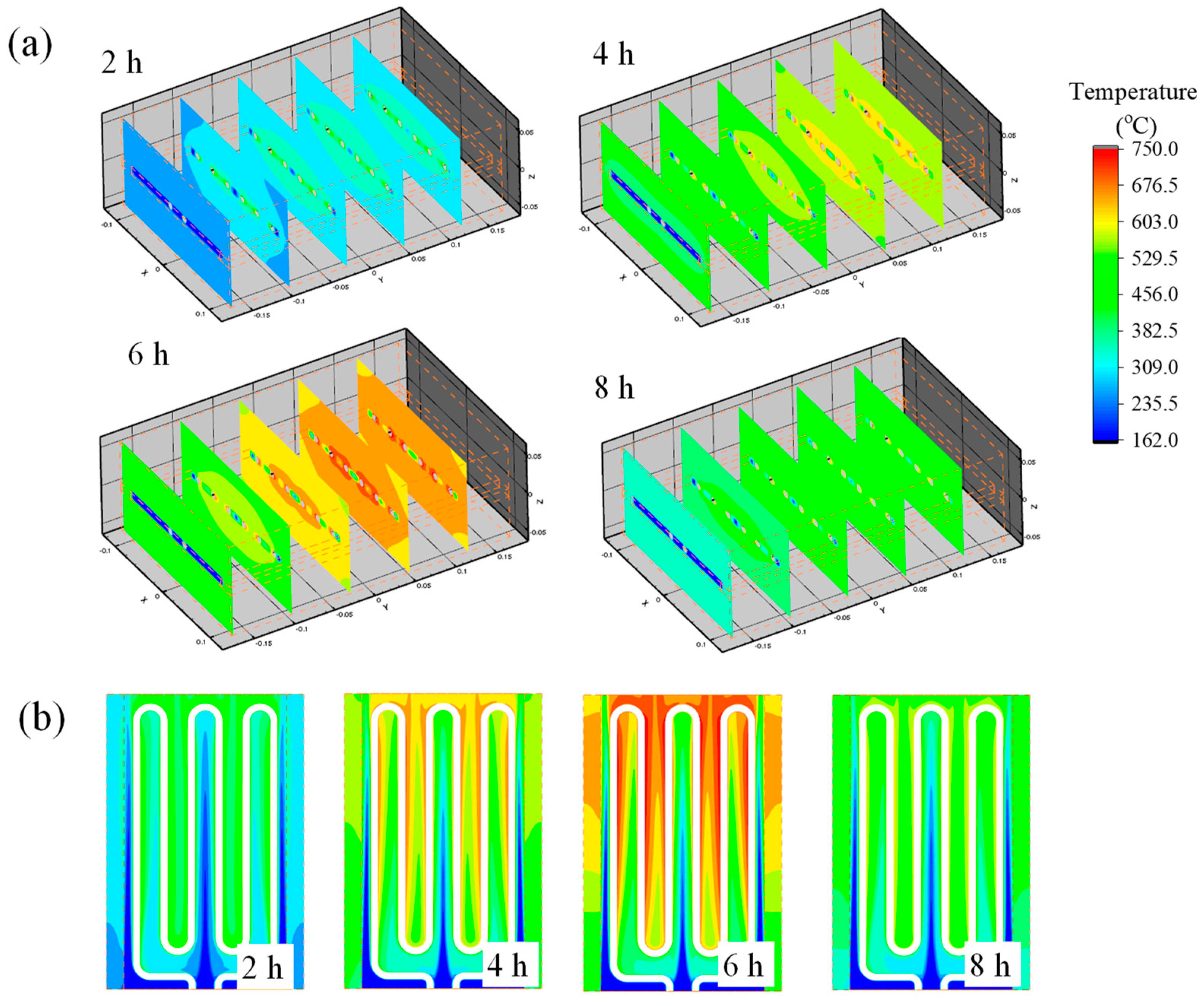
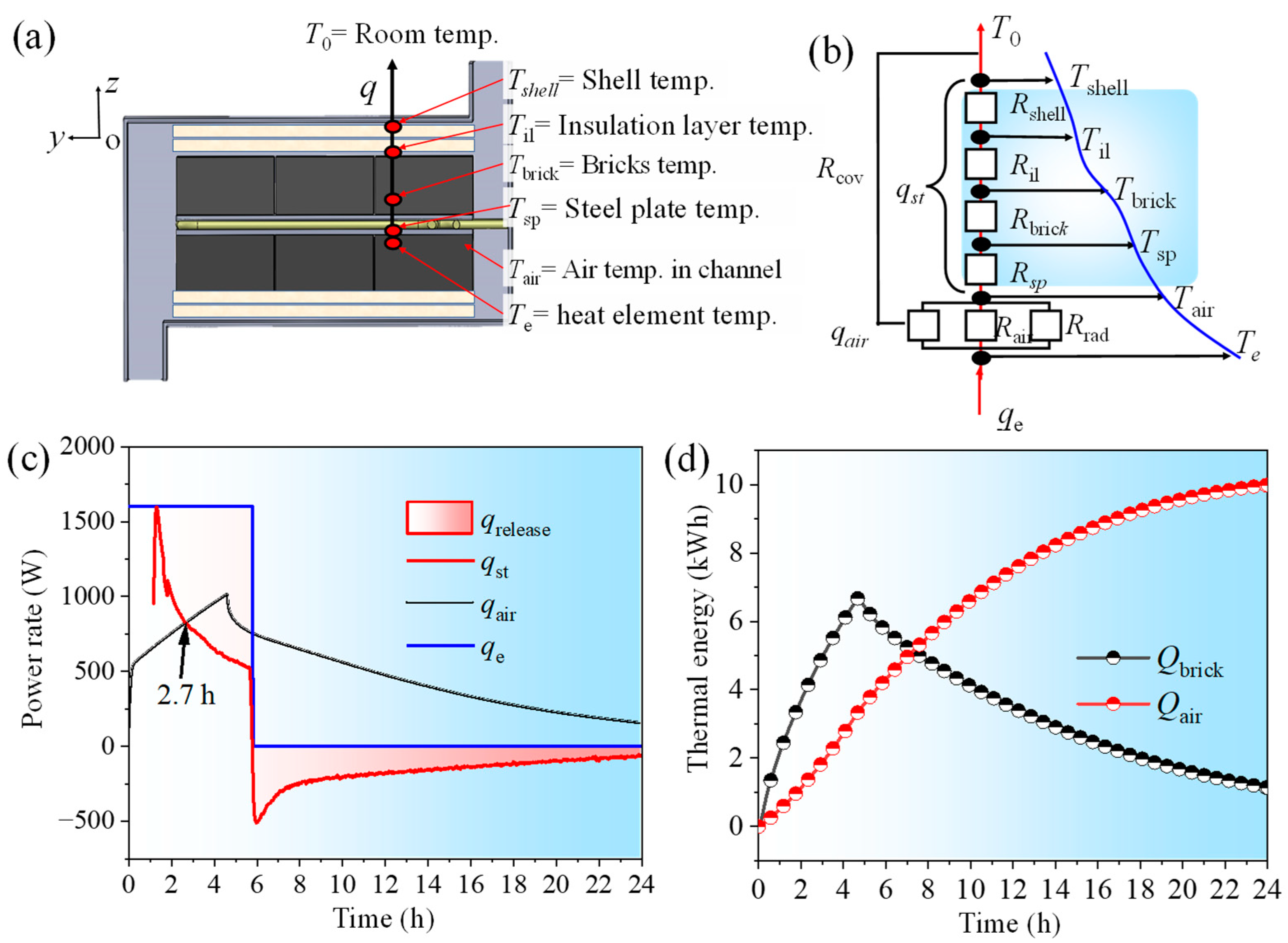
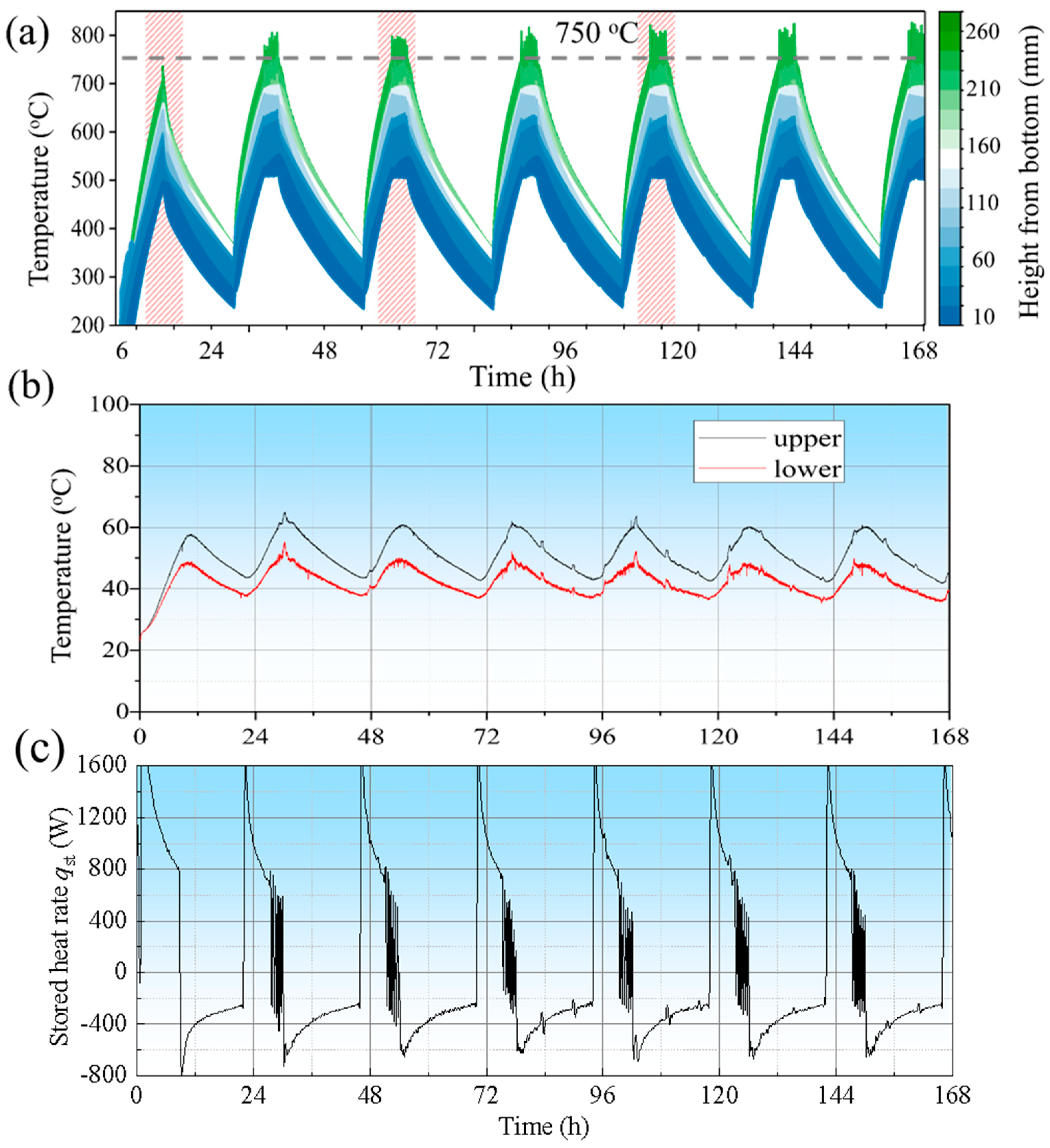
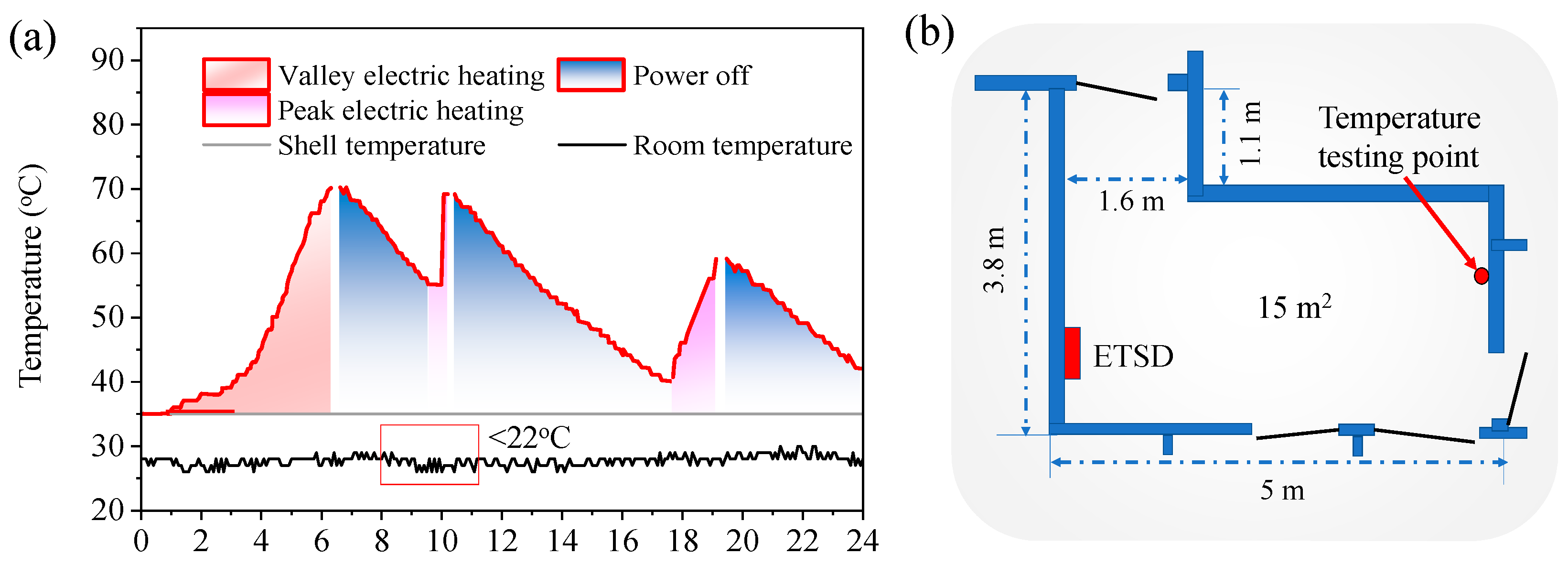
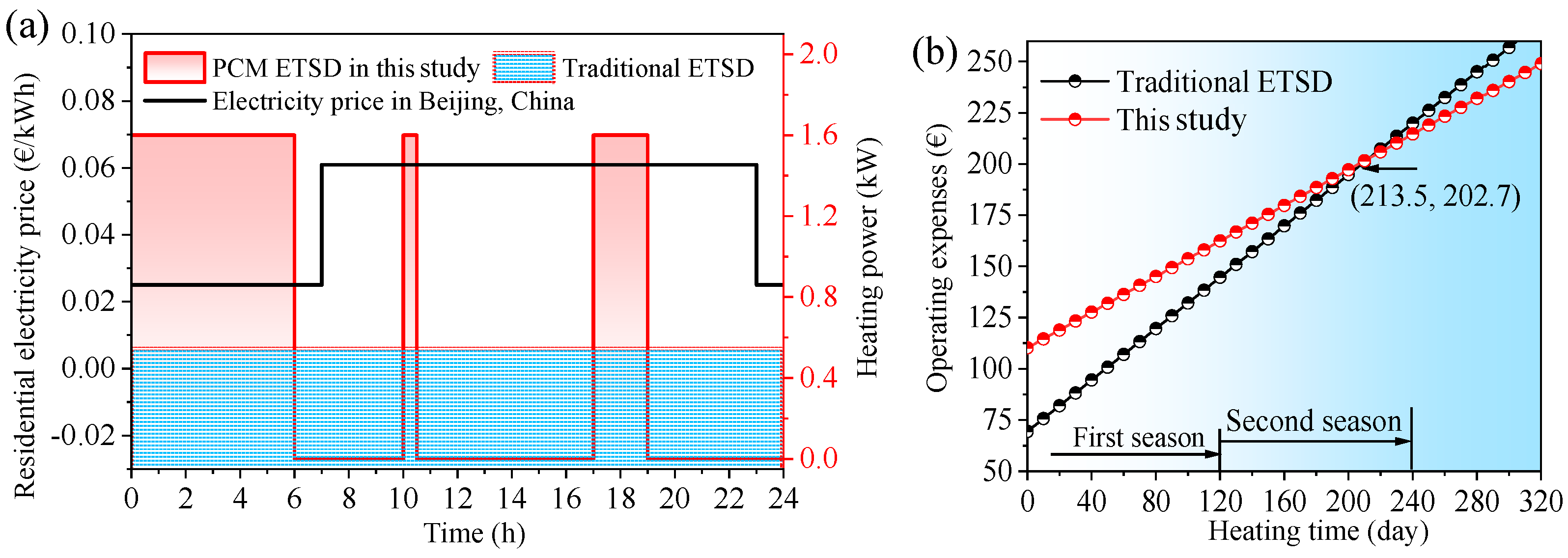
| Name | Material | Thermal Conductivity, W/(m·K) | Specific Heat, kJ/(kg·K) |
|---|---|---|---|
| Steel plate | Steel 5656 | 35.8 ± 0.25 | 0.47 ± 0.05 |
| Insulation layer [22] | Nano-adiabatic material | 0.012 ± 0.000024 | 1.12 ± 0.08 |
| Shell | Aluminum alloy | 121.5 ± 0.25 | 0.88 ± 0.03 |
| Air [23] | Air | 0.03 | 1.005 |
| Properties | Test | Reference |
|---|---|---|
| Specific heat for the solid state, kJ/(kg·K) | 1.24 | [4] |
| Specific heat for the liquid state, kJ/(kg·K) | 1.62 | [4] |
| Phase change temperature, °C | 710 | [24,25] |
| Heat of fusion, kJ/kg | 105.5 | - |
| Density, kg/m3 | 2020 | - |
| Thermal conductivity, W/(m·K) | 1.3 | [4] |
| Name | Symbol | Unit | Value |
|---|---|---|---|
| Heating power | q | kW | 1.6 |
| Heating energy | Q | kJ | 9.6 |
| Heat storage by the bricks | Qbrick | kJ | 6.09 |
| Heat storage by the steel plate | Qsp | kJ | 0.2 |
| Heat storage by the insulation layer | Qil | kJ | 0.1 |
| Heat storage by the aluminum alloy casing | Qac | kJ | 0.21 |
| Transfer to the air | Qair | kJ | 4.3 |
| Heat storage ratio | ηst | % | 48.6 |
| Traditional Electric Heater a | ETSD in This Study | |
|---|---|---|
| Heating area (m2) | 15 | |
| Price of valley time electricity in Beijing (€/kWh) | 0.025 | |
| Price of peak-time electricity in Beijing (€/kWh) | 0.061 | |
| Price of steel (€/kg) | 1.64 | |
| Price of heating cable (€/W) | 0.05 | |
| Size (mm) | 700 × 225 × 535 | 660 × 190 × 615 |
| Price of electrical control (€) | 29.6 | 30.5 |
| Price of the fan (€) | 6.7 | - |
| Price of insulation Materials (€) | - | 8.99 |
| Price of PCM (€) | - | 31.65 |
| Initial investment (€) | 69.4 | 110.2 |
| Valley heating time (h/day) | 8 | 6.5 |
| Peak heating time (h/day) | 16 | 2 |
Disclaimer/Publisher’s Note: The statements, opinions and data contained in all publications are solely those of the individual author(s) and contributor(s) and not of MDPI and/or the editor(s). MDPI and/or the editor(s) disclaim responsibility for any injury to people or property resulting from any ideas, methods, instructions or products referred to in the content. |
© 2023 by the authors. Licensee MDPI, Basel, Switzerland. This article is an open access article distributed under the terms and conditions of the Creative Commons Attribution (CC BY) license (https://creativecommons.org/licenses/by/4.0/).
Share and Cite
Pan, X.; Yuan, M.; Xu, G.; Hu, X.; Liao, Z.; Xu, C. Structure and Operation Optimization of a Form-Stable Carbonate/Ceramic-Based Electric Thermal Storage Device for Space Heating. Energies 2023, 16, 4506. https://doi.org/10.3390/en16114506
Pan X, Yuan M, Xu G, Hu X, Liao Z, Xu C. Structure and Operation Optimization of a Form-Stable Carbonate/Ceramic-Based Electric Thermal Storage Device for Space Heating. Energies. 2023; 16(11):4506. https://doi.org/10.3390/en16114506
Chicago/Turabian StylePan, Xinyu, Mengdi Yuan, Guizhi Xu, Xiao Hu, Zhirong Liao, and Chao Xu. 2023. "Structure and Operation Optimization of a Form-Stable Carbonate/Ceramic-Based Electric Thermal Storage Device for Space Heating" Energies 16, no. 11: 4506. https://doi.org/10.3390/en16114506
APA StylePan, X., Yuan, M., Xu, G., Hu, X., Liao, Z., & Xu, C. (2023). Structure and Operation Optimization of a Form-Stable Carbonate/Ceramic-Based Electric Thermal Storage Device for Space Heating. Energies, 16(11), 4506. https://doi.org/10.3390/en16114506







